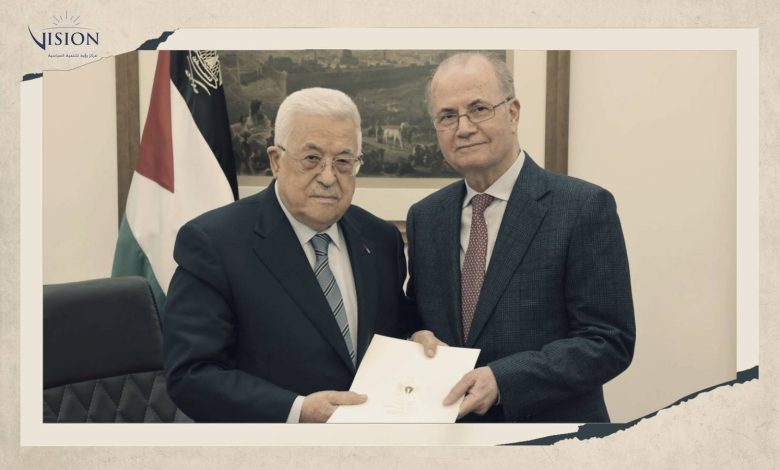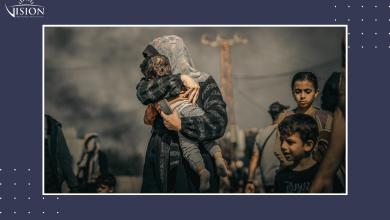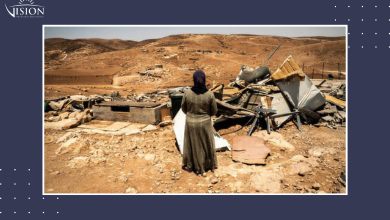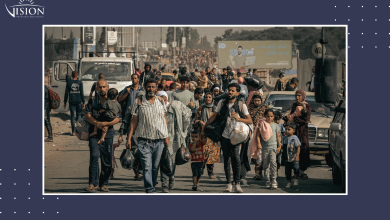The Formation of the New Palestinian Government: An Analysis of Stances and the Capacity for Continuity

Suleiman Bisharat[1]
On March 14th, Palestinian President Mahmoud Abbas entrusted Dr. Mohammad Mustafa with the formation of the 19th Palestinian government, following his acceptance of the resignation tendered by the 18th government under the leadership of Dr. Mohammad Shtayyeh, which had served for approximately five years. The Shtayyeh government’s tenure was mired in extensive debate concerning its performance at both economic and political levels, and its failure to fulfill the aspirations of the Palestinian populace; notably in its inability to achieve a breakthrough in reconciliation and internal unity, as well as in economic disengagement from the occupation as promised.
The resignation of the Shtayyeh government and the appointment of Mohammad Mustafa to form a new government has propelled Palestinian discussions to the timing of this announcement amidst the Israeli offensive on Gaza Strip, approaching the end of its sixth consecutive month. This shift stems from the Palestinian necessity for unity, as articulated by Shtayyeh in his government’s resignation letter, where he stated: “The forthcoming phase necessitates new governmental political arrangements that consider developments in the Gaza Strip, discussions on national unity, and the urgent need for a Palestinian consensus based on national fundamentals, broad participation, unity, and the extension of authority across the entire territory of Palestine.”
However, Mustafa was tasked with forming a technocratic government, the majority of whose members are distant from political life and was formed without engaging in a national consensus dialogue. This raises two questions that the report attempts to answer: What is the fate of the 19th government and its capacity for continuity amidst numerous obstacles? And what is its ability to align its program with the national and international political obligations?
Divergent Stances
As soon as the delegation for the formation of the new government was announced, various positions began to emerge from Palestinian factions and forces. Hamas, the Popular Front for the Liberation of Palestine (PFLP), the Islamic Jihad Movement, and the Palestinian National Initiative, in a joint statement, expressed that forming a new Palestinian government “without national consensus” exacerbates division and signifies a “crisis in the leadership of the Authority and the gap with the Palestinian people and their aspirations.” The factions stated that the current priority is “to confront the Israeli aggression and the war of extermination and starvation” waged by the occupation against the Gaza Strip.
In response, the Fatah movement issued a statement condemning Hamas and the other factions’ stance on “unilateralism and division” attributed to President Abbas, asserting that “the true detachment from reality and from the Palestinian people is the leadership of Hamas, which has not yet grasped the magnitude of the disaster our oppressed people are enduring.” However, Fatah’s statement, which criticized Hamas, sparked controversy within Fatah itself and among a segment of intellectuals and political activists. It also highlighted discussions about the possibility that this war could offer an opportunity for reconciliation and potentially ending the division that has lasted for more than 17 years, a notion deemed unrealistic at this juncture, as the crisis between the two movements, despite the Gaza war, may not succeed in bridging the rift between them.
The Democratic Front for the Liberation of Palestine (DFLP), on its part, called for a consensus dialogue to form a government that meets prioritizing the end of the war on Gaza, breaking the siege imposed on it, framing resistance activities, and enhancing Palestinian national unity.
On the international front, Tor Wennesland, the United Nations Coordinator for the Middle East Peace Process, welcomed this appointment, considering it “timely.” Similarly, the European Union Representative to the State of Palestine, Alexander Stutzmann, expressed his welcome, looking forward to working closely to address the forthcoming significant challenges. Russia voiced its hope that the new government would perform its duties effectively in both the West Bank and the Gaza Strip. In the same context, Germany, France, Britain, the Netherlands, and Norway greeted this development with approval.
Notably, the United States, through a statement by National Security Council spokesperson Adrian Watson, urged the formation of a reformative government as soon as possible, indicating that “the United States looks forward to this new government’s ability to implement policies and carry out credible and thorough reforms.” This could be interpreted as a hint at the necessity for compliance with American demands for what has been termed “renewed authority” in response to American expectations.
New Faces
For the first time, the composition of the Palestinian government undergoes nearly a complete transformation. Over the past two decades, Palestinians have grown accustomed to the reselection and reappointment of many officials, despite changes in government administration. For instance, the ministries of Finance, Foreign Affairs, and Social Affairs have seen no change in leadership in the last three or four governments. However, the new government’s composition marks a complete turnover of personnel, with the exception of the Minister of Interior, who has been in office for only two years. This shift represents not only a change in governmental duties but also in the approach and methodology of selection for ministerial appointments.
A closer examination of the list of new ministers, following their swearing-in before President Abbas, reveals that the majority come from academic and professional backgrounds, with no prior direct engagement in political activities. This represents a departure from previous technocratic governments, which included prominent figures from the Fatah movement and various leftist currents. Fatah, serving as the foundational reference for successive governments and having played a significant role in the nomination and selection of ministers, appears to be losing this direct influence. The selection process may have become more restricted than in the past.
Significant Challenges
The establishment of the 19th government emerges amidst a complex landscape of challenges, rendering its mission fraught with numerous risks that raise fundamental questions about its sustainability. Reevaluating the lifespan of successive Palestinian governments reveals their susceptibility to a multitude of factors, data, and challenges, which the new government is likely to face. The most prominent of these challenges include:
The Political Reference: The Palestinian society and its social composition remain under political polarization, with the influence of parties and organizations on the process of both official institutional and civil work. Therefore, detaching from this political reference in the management of any new Palestinian government will not be straightforward. Despite previous attempts to introduce models within this framework, starting with the Palestinian government formed by Salam Fayyad after the split, and followed by the Hamdallah government, they failed to overcome the influence of Palestinian organizations, especially Fatah and Hamas. Returning to the governments of Fayyad and Hamdallah, despite receiving Fatah’s endorsement at their formation, they also faced severe criticisms from the movement later on. Fatah, in its last days, contributed in one way or another to their demonization. Hence, betting that the new government could be immune to political criticism or partisan influence is unrealistic, especially under field conditions that may change, influenced by the dynamics of the war on the Gaza Strip and its Palestinian, regional, and possibly international political repercussions.
The Economic and Financial Crisis: The government of Mohammad Mustafa inherits a fiscal crisis related to the clearance revenues with the Israeli occupation, which has accumulated since the tenure of the 17th government through the 18th. The ongoing issue of collecting clearance revenues, along with the Israeli deductions, represents an impending crisis for the new government. Especially considering that clearance revenues constitute 60-65% of the total income for the Palestinian government, with the remainder comprised of local tax collections and foreign grants, which are also unstable and fluctuate according to local and international political and economic conditions. This crisis has impacted the salaries of government employees, who, due to declining financial revenues, have been receiving only 60-80% of their salaries since November 2021. Additionally, the economic crisis linked to the war on Gaza and its consequences, after the Israeli occupation destroyed the Strip’s economy, compounds these challenges.
Governing the Gaza Strip and Prospects for Internal Unity: Perhaps the most significant challenge the government faces is its ability to engage in the post-war management of the Gaza Strip, given that the aftermath of the conflict will be under a political rather than purely administrative umbrella. The perception among the Palestinian public, as well as organizations and factions, is unlikely to favorably receive what may be seen as an imposed model of governance for the sector outside of Palestinian national consensus. Any party undertaking this step might be perceived as executing American-Israeli agendas, a label the government would likely reject as being a “proxy” for American-Israeli vision. Hence, the government faces a critical test in this regard, which could define its future, potentially resulting in a loss of public trust or facing significant pressures that could lead to its displacement. This underscores the sensitivity of the government’s mission concerning the Gaza Strip, both at the collective level of the government and personally for the ministers involved, whose names may be associated with sensitive files, especially those related to the war on Gaza and its aftermath.
Additionally, the challenge of Gaza’s Reconstruction: This presents one of the greatest challenges for the new government, encompassing two primary dimensions; the first is its ability to mobilize reconstruction funds amidst the ongoing closure of prospects for the war’s future, its repercussions, and the duration of these impacts. The second dimension concerns the potential transformation of reconstruction funds into what could resemble political extortion, meaning that the government would be under Palestinian scrutiny for any decisions made away from Palestinian consensus.
Confrontation with Israel: Over the past years, and during the tenure of the 17th and 18th governments, Israel has breached many of the fundamental rules established by the agreements signed with the occupation, particularly violating the sovereignty of Palestinian cities under Palestinian security, political, and administrative control. This has portrayed previous Palestinian governments as incapable of providing the simplest elements of protection for Palestinian citizens, especially amidst attacks by settlers. Additionally, the issue of salaries for the families of prisoners and martyrs has risen to prominence and used as a pressure tactic and justification for Israeli policies. In contrast, Israel depicts successive Palestinian governments as obliged to fulfill peace agreement obligations, including providing protection for the occupation through “security coordination.” This creates a significant challenge between the occupation’s evasion of its required commitments and the attempt to fulfill the national entitlements of the Palestinian people. Despite the new government considering itself a body of experts, not a political administration, it cannot escape such obstacles that the occupation may impose, potentially leading to a confrontation with the Israeli occupation.
Conclusion
The necessity for reshaping the Palestinian government has been a popular and national demand over the years, gaining momentum with the onset of the war on the Gaza Strip. This was due to the essential need to establish either a national unity government or a national emergency government that could undertake various tasks, primarily aiming to provide means and essentials for the relief and resilience of the citizens. However, the formation of the 19th government did not achieve Palestinian consensus; instead, it emerged as a solution through which President Abbas sought to meet international demands for renewal and reform within the Authority’s institutions. Simultaneously, he managed to maintain its powers, indicating that the government would navigate through a minefield. This precarious position subjects its future to potential shifts in Palestinian, regional, or international field or political developments, rendering it a government of circumstance that may change as realities evolve. This situation is likely to keep the expectations of the Palestinian citizenry low, considering it may not possess adquate political will, alongside the economic capabilities and capacity to influence the complex Palestinian equation amid the war and its aftermath, as well as the political implications of this phase.
[1] – Researcher at Yabous for Consultations and Strategic Studies, Ramallah





